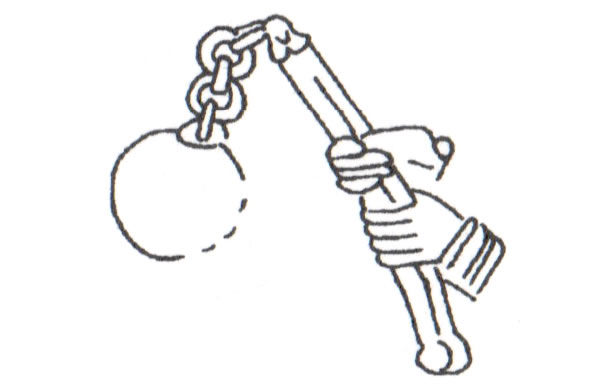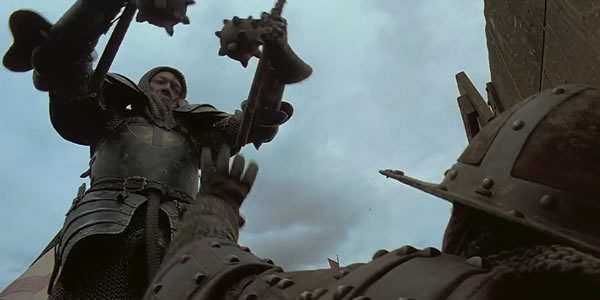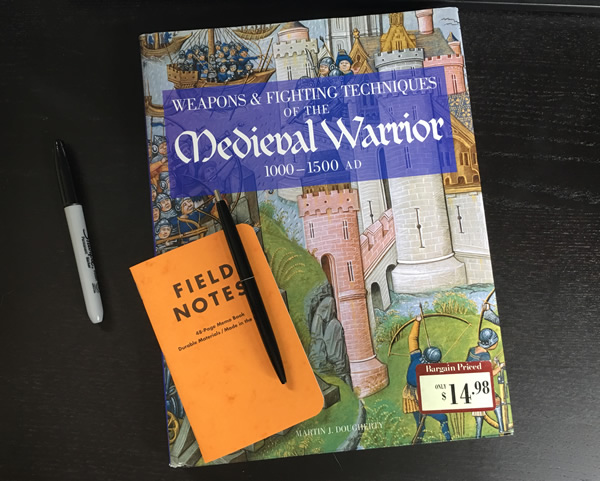Paul B. Sturtevant recently published an article at the Public Medievalist that argues the use of the ball and chain, technically called a one-handed military flail, is greatly exaggerated. More to the point, “they never existed.”
This has caused heartache for some of my friends, such as Daniel Wallace, who have a romanticized vision of the medieval knight and his choice of weaponry.

Sturtevant’s Case Against the Medieval Ball and Chain
In his article, Sturtevant makes 4 damning points against the medieval ball and chain:
- As a weapon, it is just too impractical to use.
- The most damning evidence is that it never appears in medieval descriptions of weapons nor does it appear in any armory catalogues, both of which we have plenty.
- While there are some in museums, those that do exist in places such as the Met are post-medieval “copies” (likely fakes), which never saw combat.
- That is not to say that the ball and chain does not appear in medieval art. Citing examples from the 15th-century, Sturtevant makes the astute observation that the appearance of the ball and chain is mixed in with the fantastical, and downright mythical.
Is Sturtevant right about the medieval ball and chain?
Sturtevant already quoted the two medievalists I trust with this sort of question—Kelly DeVries and Robert Douglas Smith—and they hedged their conclusion with, “It was likely that a weapon like this was used but was not common.” ((Kelly DeVries and Robert Douglas Smith, Medieval Military Technology, 2nd ed. (University of Toronto Press, 2012), 30.)) In another work, they support Sturtevant’s argument against the practicality of such a weapon, as “should the blow fail to meet its attacker, the momentum of the ball end would bring it back to injure the user!” ((Kelly DeVries and Robert D. Smith, Medieval Weapons: An Illustrated History of Impact (Santa Barbara: ABC-CLIO, 2007), 133.))
John Waldman, another medievalist, points out that such a ball and chain with spikes would continuously clang against the handle when held upright, doing damage to the shaft (see woodcut below). ((John Waldman, Hafted Weapon in Medieval and Renaissance Europe: The Evolution of Staff Weapons between 1200 and 1650 (Leiden: Brill, 2005), 146-147.))

Waldman also believes that the obvious danger to the wielder accounts for the scarcity of the weapon in medieval descriptions and armory catalogues. ((John Waldman, Hafted Weapon in Medieval and Renaissance Europe, 146.))
In reviewing David Nicolle’s catalogue of Arms & Armour of the Crusading Era, I found a single 12th-century depiction of a ball and chain.

It comes from a surviving arch from San Miguel de Uncastillo in Aragón, but Nicolle emphasizes that
This beautifully carved arch may be responsible for one of the greatest popular fallacies in arms and armour, one that Hollywood continues to perpetuate despite massive evidence to the contrary. Namely that the ‘ball and chain’ was a typical knightly weapon. ((David Nicolle, Arms & Amour of the Crusading Era, 1050-1350: Western Europe and the Crusader States (London: Greenhill Books, 1999), 130, 415, fig. 326i.))
Unfortunately, I could not track down a high-res image of the carving. The best I found was a photo hosted by the Museum of Fine Arts in Boston, which also has a replica of the arch.

While this may give romantics hope that there was at least a brave few willing to wield a ball and chain, the reality is that this single depiction prior to the fanciful depictions in the 15th-century is not enough to conclude that anyone actually used this weapon seriously.
Hollywood, Barnes & Noble
Even with academics emphasizing this lack of evidence, Hollywood and coffee table books will continue to dominate this discussion. Concerning the former, it might be easier to count the number of medieval movies without a ball and chain.

As for books, most households do not contain the very accessible Medieval Military Technology by DeVries and Smith, the former of which is likely the most prolific, living historian writing about medieval warfare. I would be shocked to find a copy of Waldman’s $150 Hafted Weapons anywhere outside a university.
Instead, people are buying Barnes & Noble bargain coffee table books such as Martin J. Dougherty’s Weapons & Fighting Techniques of the Medieval Warrior, which is on at least its third incarnation (2008, 2011, 2016) and even has a Spanish translation. ((On LibraryThing, Dougherty’s 2008 and 2011 editions have more than 5 times the number of owners than either of DeVries and Smith’s or Waldman’s books.))

Dougherty, who has pumped out dozens of giant books on warfare from all periods, tells us that “flails became a trademark weapon of Crusader fanatics but were also used by more conventional troops.” ((Martin J. Dougherty, Weapons & Fighting Techniques of the Medieval Warrior, 1000-1500 AD (New York: Metro Books, 2008), 91.)) How did he come to this conclusion? He doesn’t cite any sources, so your guess is as good as mine. Our earliest surviving depiction from a 12th-century Spanish archway is hardly enough for me to conclude it was a trademark weapon of anyone, let alone “Crusader fanatics,” whatever that means.

Dougherty is by no means alone. Edwin Tunis’s Weapons: A Pictorial History has been in print since 1954. He tells us
The Saxons also worked a variation on the mace which must have had great possibilities in the hands of a good man. It was called by a gentle and poetic name—the “morning-star.” Its heavy, usually spiked head was attached to a handle by a short length of chain, and though it might be a little hard to control, when it did land it took the fight out of the toughest Norman. ((Edwin Tunis, Weapons: A Pictorial History (Baltimore: The John Hopkins Univeristy Press, 1999), 35-36.))
How popular are books like these? I asked a gaming friend what he knew of the medieval ball and chain, or military flail. He pulled Tunis’s book off his shelf and showed me this picture.

Tunis paved the way for Dougherty and others to publish large, picturesque books with virtually no sources to back their claims.
Still, expect to see an incarnation of Dougherty’s book at Barnes & Noble for the foreseeable future. He and Hollywood will keep the dream of the medieval ball and chain alive.

